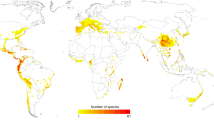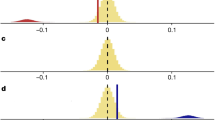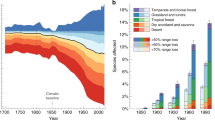Abstract
Although there is growing concern that amphibian populations are declining globally1,2,3, much of the supporting evidence is either anecdotal4,5 or derived from short-term studies at small geographical scales6,7,8. This raises questions not only about the difficulty of detecting temporal trends in populations which are notoriously variable9,10, but also about the validity of inferring global trends from local or regional studies11,12. Here we use data from 936 populations to assess large-scale temporal and spatial variations in amphibian population trends. On a global scale, our results indicate relatively rapid declines from the late 1950s/early 1960s to the late 1960s, followed by a reduced rate of decline to the present. Amphibian population trends during the 1960s were negative in western Europe (including the United Kingdom) and North America, but only the latter populations showed declines from the 1970s to the late 1990s. These results suggest that while large-scale trends show considerable geographical and temporal variability, amphibian populations are in fact declining—and that this decline has been happening for several decades.
This is a preview of subscription content, access via your institution
Access options
Subscribe to this journal
Receive 51 print issues and online access
$199.00 per year
only $3.90 per issue
Buy this article
- Purchase on Springer Link
- Instant access to full article PDF
Prices may be subject to local taxes which are calculated during checkout



Similar content being viewed by others
References
Wake,D. B. Declining amphibian populations. Science 253, 860 (1991).
Blaustein,A. R. & Wake,D. B. Declining amphibian populations: A global phenomenon? Trends Ecol. Evol. 5, 203–204 (1990).
Blaustein,A. R., Wake,D. B. & Sousa,W. P. Amphibian declines: judging stability, persistence, and susceptibility of populations to local and global extinctions. Conserv. Biol. 8, 60–71 (1994).
Wake,D. B. & Morowitz,H. J. Declining amphibian populations—a global phenomenon? Findings and recommendations. Alytes 9, 33–42 (1991).
Pechmann,J. H. K. & Wilbur,H. M. Putting declining amphibian populations in perspective: natural fluctuations and human impacts. Herpetologica 50, 65–84 (1994).
Lips,K. R. Decline of a tropical montane amphibian fauna. Conserv. Biol. 12, 106–117 (1998).
Harte,J. & Hoffman,E. Possible effects of acidic deposition on a Rocky Mountain population of the tiger salamander Ambystoma tigrinum . Conserv. Biol. 3, 149– 158 (1989).
Corn,P. S. & Fogleman,J. C. Extinction of montane populations of the northern leopard frog (Rana pipiens) in Colorado. J. Herpetol. 18, 147–152 (1984).
Pechmann,J. H. K. et al. Declining amphibian populations: The problem of separating human impacts from natural fluctuations. Science 253 , 892–895 (1991).
Meyer,A. H., Schmidt,B. R. & Grossenbacher, K. Analysis of three amphibian populations with quarter-century long time-series. Proc. R. Soc. Lond. B 265, 523–528 (1998).
Hecnar,S. J. & M'Closkey,R. T. Spatial scale and determination of species status of the green frog. Conserv. Biol. 11, 670–682 (1997).
Hecnar,S. J. & M'Closkey,R. T. Regional dynamics and the status of amphibians. Ecology 77, 2091– 2097 (1996).
Weygoldt,P. Changes in the composition of mountain stream frog communities in the Atlantic mountains of Brazil—frogs as indicators of environmental deteriorations. Stud. Neotrop. Fauna Environ. 24, 249– 255 (1989)
Berger,L. et al. Chytridiomycosis causes amphibian mortality associated with population declines in the rain forests of Australia and Central America. Proc. Natl Acad. Sci. USA 95, 9031– 9036 (1998).
Pounds,J. A., Fogden,M. P. L., Savage,J. M. & Gorman,G. C. Tests of null models for amphibian declines on a tropical mountain. Conserv. Biol. 11, 1307–1322 (1997).
Laurance,W. F., McDonald,K. R. & Speare, R. Epidemic disease and the catastrophic decline of Australian rain forest frogs. Conserv. Biol. 10, 406 –413 (1996)
Drost,C. A. & Fellers,G. M. Collapse of a regional frog fauna in the Yosemite area of the California Sierra Nevada, USA. Conserv. Biol. 10, 414–425 ( 1996).
Pounds,J. A., Fogden,M. P. L. & Campbell, J. H. Biological response to climate change on a tropical mountain. Nature 398, 611– 615 (1999).
Beebee,T. J. C. et al. Decline of the natterjack toad Bufo calamita in Britain: paleoecological, documentary and experimental evidence for breeding site acidification. Biol. Conserv. 37, 59– 71 (1990).
Carey,C. Hypothesis concerning the causes of the disappearance of boreal toads from the mountains of Colorado. Conserv. Biol. 7, 355–362. (1993).
Cunningham,A. A. et al. Unusual mortality associated with poxvirus-like particles in frogs (Rana temporaria). Vet. Rec. 133, 141–142 (1993).
Blaustein,A. R. et al. Effects of ultraviolet radiation on amphibians: Field experiments. Am. Zool. 38, 799–812 (1998).
Kiesecker,J. M. & Blaustein,A. R. Synergism between UV-B radiation and a pathogen magnifies amphibian embryo mortality in nature. Proc. Natl Acad. Sci. USA 92, 11049–11052 (1995).
Long,L. E., Saylor,L. S. & Soule, M. E. A pH/UV-B synergism in amphibians. Conserv. Biol. 9, 1301–1303 ( 1995).
Wake,D. B. Action on amphibians. Trends Ecol. Evol. 13, 379–380 (1998).
Tyler,M. J. Declining amphibian populations: a global phenomenon? An Australian perspective. Alytes 9, 43–50 (1990).
Green,D. M. in Amphibians in Decline: Canadian Studies of a Global Problem (ed. Green, D. M.) 291–308 (Society for the Study of Amphibians and Reptiles, Lawrence, USA, 1997).
Englund,G., Sarnelle,O. & Cooper, S. D. The importance of data-selection criteria: meta-analysis of stream predation experiments. Ecology 80, 1132–1141 (1999).
Draper,N. R. & Smith,H. Applied Regression Analysis 2nd edn (Wiley and Sons, New York, 1981).
Heyer,W. R., Donnelly,M. A., McDiarmid, R. W., Hayak,L. A. C. & Foster,M. S. (eds) Measuring and Monitoring Biological Diversity: Standard Methods for Amphibians (Smithsonian Institute Press, Washington, 1994).
Acknowledgements
We thank all the researchers who contributed amphibian population data and, in particular, J. Loman, T. Beebee and S. Zumbach for large unpublished data sets. This work was supported by Wildlife Habitat Canada, the Natural Sciences and Engineering Research Council of Canada, and the Schweizerischer Nationalfonds.
Author information
Authors and Affiliations
Corresponding author
Supplementary information
41586_2000_BF35008052_MOESM1_ESM.doc
Supporting documentation of the 936 amphibian population time series used in 'Quantitative evidence for global amphibian population declines'. (DOC 97 kb)
Rights and permissions
About this article
Cite this article
Houlahan, J., Findlay, C., Schmidt, B. et al. Quantitative evidence for global amphibian population declines. Nature 404, 752–755 (2000). https://doi.org/10.1038/35008052
Received:
Accepted:
Issue Date:
DOI: https://doi.org/10.1038/35008052
This article is cited by
-
Sensitive and efficient surveillance of Japanese giant salamander (Andrias japonicus) distribution in western Japan using multi-copy nuclear DNA marker
Limnology (2024)
-
Larval prey options for the endangered species Dytiscus sharpi (Coleoptera: Dytiscidae: Dytiscinae) for sustainable ex-situ conservation
Journal of Insect Conservation (2023)
-
Realistic scenarios of pesticide exposure alters multiple biomarkers in BOANA PULCHELLA (ANURA) Adult Frogs
Ecotoxicology (2023)
-
Factors influencing persistence of a threatened amphibian in restored wetlands despite severe population decline during climate change driven weather extremes
Biodiversity and Conservation (2022)
-
Using mesocosms to evaluate the impacts of pasture intensification and pasture-sugarcane conversion on tadpoles in Brazil
Environmental Science and Pollution Research (2022)
Comments
By submitting a comment you agree to abide by our Terms and Community Guidelines. If you find something abusive or that does not comply with our terms or guidelines please flag it as inappropriate.



